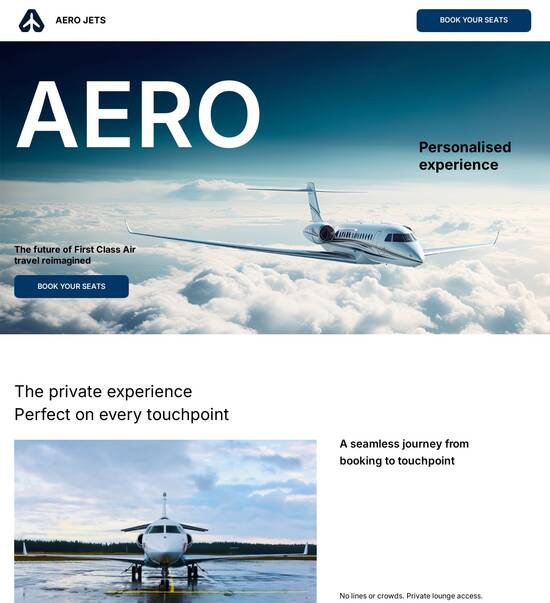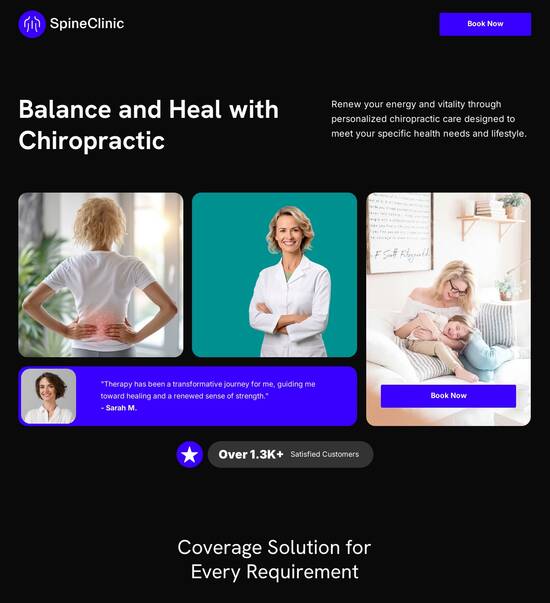
HTML page template for plane companies
Use TemplateAbout template
Give your plane companies a boost with our professional landing page templates. Ready to turn visitors into customers?
Recommended templates

Easy to build without coding
With the intuitive drag-and-drop builder, anyone on your team can create high-converting pages without any knowledge of code or design. Make enhancements to your landing page with custom widgets using Javascript, HTML/CSS, or third-party scripts.

Multiple layouts for any industry and goal
Select from 500+ landing page layouts built to boost conversions across industry-specific scenarios. Customize them by adjusting fonts, adding images, and generating on-brand content with the AI assistant. Quickly scale with Instablocks® and Global Blocks that you can save, reuse, and update globally.

Loads fast and looks polished on any device
Every template is responsive, which means they present professionally on any device and load blazingly fast with our Thor Render Engine. You can also power them up with Google AMP technology to deliver an unparalleled mobile experience and drive higher conversions.

Robust analytics & experimentation
Get real-time updates and reporting across all your devices, showing the number of visitors, conversions, cost-per-visitor, and cost-per-lead. Launch AI-powered experiments, run A/B tests, and use heatmaps to analyze user behavior, then optimize your landing page to maximize conversions.







Easy to build without coding
With the intuitive drag-and-drop builder, anyone on your team can create high-converting pages without any knowledge of code or design. Make enhancements to your landing page with custom widgets using Javascript, HTML/CSS, or third-party scripts.
Multiple layouts for any industry and goal
Select from 500+ landing page layouts built to boost conversions across industry-specific scenarios. Customize them by adjusting fonts, adding images, and generating on-brand content with the AI assistant. Quickly scale with Instablocks® and Global Blocks that you can save, reuse, and update globally.
Loads fast and looks polished on any device
Every template is responsive, which means they present professionally on any device and load blazingly fast with our Thor Render Engine.
Robust analytics & experimentation
Get real-time updates and reporting across all your devices, showing the number of visitors, conversions, cost-per-visitor, and cost-per-lead. Launch AI-powered experiments, run A/B tests, and use heatmaps to analyze user behavior, then optimize your landing page to maximize conversions.
All the features you need to build sample plane tickets
Explore more featuresLearn how to build airlines website template
FAQs
Leading the way in building high-performing landing pages





Mastering Landing Pages with Instapage: Your Ultimate Guide
A powerful landing page and conversion rate optimization (CRO) platform, Instapage empowers marketers to enhance their campaigns. With features tailored for industries such as tech, education, and financial services, Instapage streamlines the creation of high-impact landing pages that convert visitors into leads.
Why Choose Instapage for Landing Page Development?
Instapage offers a seamless solution for building landing pages that resonate with your audience. As a marketing professional, utilizing this platform means leveraging over 100 customizable, conversion-driven templates. This ensures that your campaigns captivate visitors from the moment they land on your page.
- Accessibility of Templates: Choose from a rich library of pre-designed templates that cater to various industries, reducing your time to launch campaigns.
- User-Friendly Interface: Instapage's intuitive drag-and-drop builder allows marketers with no coding experience to create stunning landing pages.
- Analytics Integration: Track user behavior and conversions to gather insights that encourage data-driven decisions and improve ROI.
Steps to Create Effective Landing Pages
Creating an impactful landing page involves a structured approach. Here's how to get started with Instapage:
- Choose a Template: Select from a variety of high-converting templates that fit your campaign's goals.
- Customize Your Page: Utilize Instablocks and easy editing tools to tailor your content, images, and calls to action specifically for your target audience.
- Optimize for Conversions: Employ A/B testing, heat maps, and detailed analytics to determine what works best and refine your approach continually.
Optimizing Landing Pages for Higher Conversions
Optimizing your landing pages is key to maximizing conversions. Here are important strategies:
- Utilize A/B Testing: Experiment with different headlines, images, and calls to action to see what resonates best with your audience.
- Implement Heatmaps: Understand user behavior on your page and make data-driven adjustments to your layout and content.
- Leverage Personalization: Use dynamic text replacement and specific audience-targeted content to create tailored experiences.
Ultimately, leveraging Instapage's features will streamline your marketing efforts and boost your overall campaign effectiveness.
With a robust set of tools at your disposal, there's no limit to what you can achieve in enhancing your landing page strategies.
Get started with Instapage today, and transform how you connect with your audience online!
People also ask about HTML page template for plane companies
HTML Page Template for Plane Companies
Understanding HTML page templates for airplane companies
HTML page templates serve as pre-designed frameworks that streamline the process of building and maintaining websites. For airplane companies, these templates are crucial as they ensure brand consistency across digital platforms while enhancing user experience. By employing templates, aviation companies can offer a uniform look and feel across their services, thereby reinforcing brand identity and making navigation intuitive for customers.
The evolution of web design in the aviation sector has been substantial, progressing from static pages in the early days of the internet to today's dynamic and responsive templates. Initially, airline websites were limited in functionality and visual appeal, often providing only basic flight information. As technology advanced and consumer expectations grew, the industry shifted toward more interactive and user-friendly designs, embracing templates that allowed for quick updates and rich media integration.
Key features of HTML page templates
One of the most appealing aspects of HTML page templates is their customizable layouts that can cater to diverse airline services, including commercial flights, cargo logistics, and charter operations. These adaptable layouts typically include various sections like hero images, flight booking forms, and destination showcases, allowing companies to highlight their brand and services effectively. Each template can be tailored to suit different audience segments, which is vital in this competitive market.
User-centric design principles are integral to the effectiveness of HTML templates. They enhance customer experience by prioritizing intuitive navigation and ensuring that information is readily accessible. Important features include mobile responsiveness—critical in an age where many users access services via mobile devices—and accessibility options for users with disabilities, making sure that airline services are inclusive and welcoming to all.
Customizable layouts for diverse airline services
User-centric design principles enhancing customer experience
Integration capabilities with booking systems for real-time information
Enhancing user interaction through JavaScript functions
JavaScript plays a vital role in enhancing the functionality of static HTML templates, transforming them into interactive platforms. By implementing event listeners, companies can track user interactions in real-time. For instance, using `document.addEventListener` allows developers to respond to various events, such as clicks and form submissions, thereby enriching user engagement. This interaction is critical for capturing customer preferences and behaviors, leading to tailored marketing strategies and improved services.
Furthermore, ensuring content is ready with the `DOMContentLoaded` event is essential for improving user experience. By loading essential scripts and resources only after the HTML document has been completely loaded, airlines can significantly enhance website performance. Common tasks executed upon this event may include displaying animations, fetching real-time data, and evaluating user inputs efficiently, all of which contribute to a seamless user experience.
The benefits of HTML page templates for airplane companies
Adopting HTML page templates provides substantial cost-effectiveness compared to custom web development. Custom sites often require extensive resources, both financially and in terms of time, while templates offer a one-time investment for immediate returns. As aviation companies commit to their digital presence, a well-designed template can prove valuable in the long run, saving costs associated with ongoing maintenance and updates.
In addition to cost savings, these templates accelerate development time significantly. Marketers can move swiftly from template selection to launch, utilizing pre-built components and schema structures to ensure they meet industry standards. SEO optimization is also a notable feature, as several templates come equipped with built-in SEO tools that improve visibility in search engines. By following best practices, airlines can leverage these features effectively to attract more traffic and ultimately boost bookings.
Finally, another considerable advantage of using HTML page templates is the ease of updates and ongoing maintenance. Many template frameworks are designed to support straightforward updates with minimal downtime, crucial for maintaining an airline's operational efficiency. Additionally, keeping up with security patches and version control is vital, especially in an industry as sensitive as aviation.
Case studies: Successful implementations of HTML page templates
Several leading airlines have successfully implemented HTML page templates to enhance their online presence significantly. For example, major international airlines utilize customizable templates that allow them to present information dynamically, such as flight schedules and promotional offers. Distinct sections such as travel guides, customer testimonials, and loyalty programs provide users with interactive content, enhancing engagement and elevating branding.
Feedback from executives in the aviation industry reflects the tangible benefits observed after transitioning to HTML templates. Many report increased customer satisfaction due to faster load times and more intuitive navigation. These improvements have resulted in higher booking rates, as travelers find it easier to navigate flight options and complete transactions securely.
Future trends in HTML page templates for airlines
The future of HTML page templates for airlines is poised to integrate emerging technologies such as artificial intelligence and machine learning. These advancements will enable templates to adapt to user preferences dynamically, utilizing predictive analytics to enhance the customization of services. As flight booking becomes even more personalized, airlines can create tailored experiences that speak directly to individual traveler needs.
Another trend gaining traction is the shift towards sustainability in web design. As the aviation industry looks to reduce its environmental impact, eco-friendly HTML templates are emerging. Key features of sustainable templates include energy-efficient hosting options and designs that optimize loading times to minimize data consumption, providing a win-win for both the environment and operational efficiency.
Moreover, the incorporation of augmented reality (AR) and virtual reality (VR) capabilities is becoming increasingly relevant. These features allow airlines to provide immersive experiences for passengers, such as virtual tours of planes, destinations, and lounges. By leveraging AR/VR technologies, airlines can engage customers in innovative ways, ultimately enhancing their journey even before takeoff.
Best practices for implementing HTML page templates
When choosing the right HTML page template, airlines should consider several factors, including branding consistency, functionality, and user interface design. Not all templates are created equal, so research into industry-specific designs is essential. Some reputable resources include template libraries and reputable web design firms that specialize in the aviation industry.
Customizing templates for brand identity is crucial. Airlines should leverage their unique colors, logos, and typography to maintain their brand personality. Doing so helps create an emotional connection with customers and enhances brand loyalty. Additionally, A/B testing strategies are recommended for optimization, enabling airlines to refine landing pages based on real data.
Choose templates that align with brand identity and marketing goals.
Utilize A/B testing to assess the effectiveness of various design elements.
Regularly monitor user behavior to identify areas for improvement.
Frequently asked questions about HTML page templates for airlines
Many airlines express concerns about the adaptability of HTML templates, fearing they lack customization options. However, modern templates are often highly flexible, allowing airlines to modify and create unique features that align with their branding and operational needs. It's essential to select templates from reputable sources to ensure quality and responsiveness.
For new airline startups, leveraging HTML templates can be a game changer in a competitive market. By implementing effective designs from the onset, new companies can focus on building their customer base and refining their services, rather than dedicating excessive resources to web development. Prioritizing essential elements like user experience and SEO optimizations can provide a significant advantage.
Final thoughts on the importance of HTML page templates in aviation
In summary, HTML page templates offer substantial value to the airline industry by enhancing brand consistency, user experience, and operational efficiency. As companies seek to improve their online presence and meet customer expectations, adopting these tools can lead to significant competitive advantages. By embracing best practices and emerging technologies, airlines can pave the way for innovative customer interactions and long-term loyalty.
Encouraging continuous innovation through the adoption of these templates is vital. With the ongoing evolution of digital design and technology, staying adaptive and forward-thinking will empower airlines to maintain relevance and success in a rapidly changing landscape.
Ready to skyrocket conversions?
Supercharge your ad campaigns with high-performing landing pages
Get started














